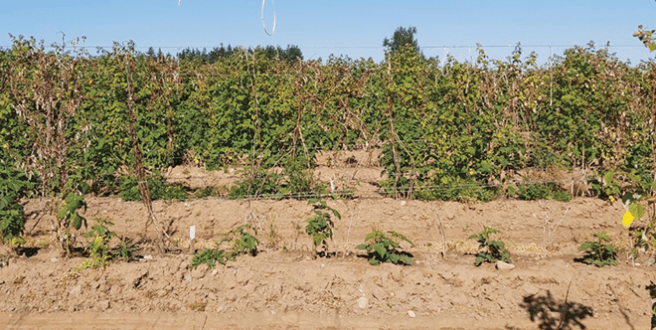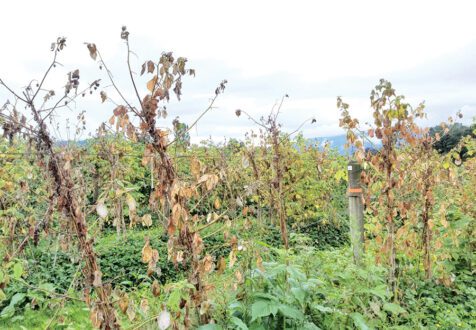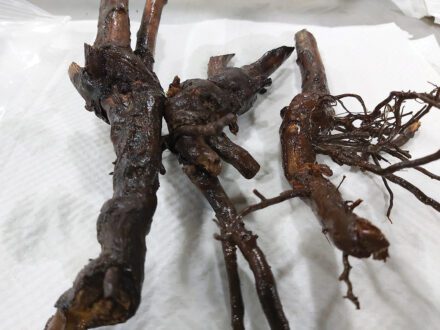

Mar 18, 2024Raspberry root rot, wilt threaten fruit in wet regions
Raspberry root rot and wilt (RRW) in British Columbia, Canada and the U.S. Pacific Northwest is a common problem faced by growers, with the vigor of plants declining and leading to fruit losses and the death of plants within six years — cutting the life cycle in half.
Caused by the plant-damaging oomycetes (water molds) known as Phytopthora, RRW in raspberries leads to millions of dollars in losses, and is the most important problem for the berries that U.S. and Canadian growers face, according to Rishi Burlakoti, a research scientist in plant pathology at Agriculture and Agri-Food Canada’s Agassiz Research and Development Center in Agassiz, British Columbia.


Burlakoti and other scientists wrapped up a five-year study on raspberry RRW in 2023, but there are plans to build on what they found through the government and industry-funded research.
Moisture triggers the soilborne pathogen, allowing it to attach to root tips and blocking nutrient and water uptake. Compounding the problem is the pathogen’s ability to remain dormant for up to 10 years.
“Motile spores will infect plants via roots, colonize the root tissue and ultimately move to stem base and above-ground plant tissue,” Burlakoti said. “The pathogen may block the vascular system of the plant, interfere with the water and nutrient movement, causing wilting symptoms in plants. Multiple cycles of infection could happen in a single growing season.”
Multiplex targeted sequencing


Burlakoti and this team collaborated with Kurt Lamour, an expert in the molecular study of Phytophthora species at the University of Tennessee’s Department of Entomology and Plant Pathology. The novel technique allowed them to compare numerous pathogens found in different fields and in multiple raspberry varieties against a database of known Phytophthora species.
Burlakoti, who is comfortable doing field research and collecting results and plant material in the field, and Lamour, a genomics expert in the lab, made a good team on the project. They confirmed that Phytophthora was in 55%-100% of the different raspberry fields they tested from 2018-2020, with the commonly grown cultivars Chemainus, Rudi and Meeker most susceptible.
In those cultivars, 85% of the pathogen isolates were Phytophthora rubi, (P. rubi) with the remaining 15% identified as Phytophthora gonapodyides, of which the cultivar Cascade Bounty was more susceptible.
Screening for disease resistance
Before raspberry RRW-resistant varieties can be bred, screening methods must be developed to determine which ones are the most reliable. P. rubi was introduced to the susceptible Chemainus and the moderately-resistant Cascade Bounty, which were monitored for RRW symptoms.
Over the course of the project, the researchers identified five methods breeders can evaluate raspberry varieties. Burlakoti worked with breeder Michael Dossett of BC Berry Cultivar Development Inc. on the project, and the research and development center’s team and Dossett published their findings in a paper, “Development of effective method for pathogenicity and screening of Phytophthora spp. on red raspberry seedlings.”


raspberry growers in wetter climates, including the Pacific
Northwest and British Columbia, Canada.
“I work very closely with him in different aspects for resistance breeding. That means trying to help to screen the materials and then he incorporates resistance breeding materials in his breeding program.”
They also studied virulence diversity in P. rubi, collecting samples from throughout British Columbia fields, finding that more than 75% of isolates produced severe wilting and root rot symptoms.
Multipronged approach to fight RRW in raspberries
Burlakoti said planting disease-resistant varieties is always a good option, but the “dynamics between the pathogen and plant interaction” means that initial resistance in the field will at some point be surpassed by a pathogen.
Fungicide applications in early spring and fall are key, he said, with foliar fungicides (fosetyl-Al, FRAC group 33) and soil application of metalaxyl-m, commercially known as Ridomil Gold (FRAC group 4), oxathiapiprolin (FRAC group 49) and cyazofamid (FRAC group 21) registered in Canada.
Cultural practices, including proper drainage, avoiding planting in heavy soils, using raised beds with plastic or other mulches should also be integrated into programs to fight the disease.
— Chris Koger, managing editor
Top photo: Plants in this raspberry field exhibit symptoms of root rot and wilt, which stunts growth by blocking water and nutrient uptake. The fungal disease, if untreated, will eventually kill the plant. Photos courtesy Agriculture and Agri-Food Canada.














